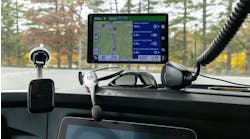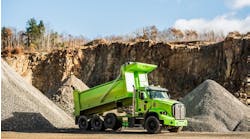The sun is setting on the third generation of cellular communication technology, creating a potential pain point for fleets that put off upgrading their electronic logging devices—and other communication systems on vehicles and trailers—before the COVID-19 pandemic upended the supply chain.
“The 3G sunset couldn’t have come at a worse time given everything else that we have going on with the demand on freight,” Nada Jiddou, EVP of Clarience and general manager of Road Ready, told FleetOwner.
With the long wait times fleets now face at ports around the U.S., to have to pull a tractor or trailer out of operation to upgrade its communications from 3G “exasperates the problem. If you’re putting it off and 3G is sunsetting, now you’ve lost visibility to those devices, and the optimization that you were getting from being able to manage locations of your trailers and tractors is lost,” she said.
The supply chain problems of 2021 are adding to the network upgrade concerns for 2022, David Heller, Truckload Carriers Association VP of government affairs, told FleetOwner. “If you’re not having conversations with your telematics providers, you need to start because you need to make sure that the equipment you’re actually using will continue to work as we get into 2022.”
Time is running out for fleets that put off upgrades. “If fleets haven’t started now, they should do something tomorrow,” Andrew Rossington, chief product officer at Teletrac Navman, told FleetOwner this week. “I don't think we could have predicted—even at the start of this year—what impact this was going to have on the supply chain.”
With so many consumer, transportation, and technology companies having the same microchip supply problems this year, if a fleet hasn’t begun to address the 3G sunset, it could find itself behind the competition in 2022. “Not only are we running out of time, but we’re also running out of available equipment—across the technology industry to be able to service those customers,” Rossington said of the overall supply chain impact on upgrades.
Make way for 5G
With AT&T’s sunset up first and three major U.S. holidays coming up over the next seven weeks, Rossington noted, “there are not a lot of working weeks left.” And for any vehicles with older ELD systems installed, they would need to go out of service for at least 30 to 60 minutes “for a very efficient changeover.” Less efficient upgrades could require even more time.
“If you think about how many people have perhaps not planned this well, there's a very high demand on engineering services to do those changes,” he said. Plug-and-play type devices could require less downtime for trucks and tractors, “but there’s still a disruption.”
Even though carriers such as Verizon have more than a year before their network officially abandons 3G, Rossington said 3G service on all networks will become less and less reliable because carriers aren’t going to invest money in maintaining something they are about to abandon.
Mobile carriers are ending 3G to make more room for 5G expansion as the need for faster data grows for consumers and the transportation industry. After years of being behind in technology advances, the trucking industry is moving from slow adoption to embracing new, faster ways to link data. Back in the early 2000s, when 3G service first became prevalent, equipment and bandwidth were more expensive.
“Back then, GPS-type location services were for the people with deeper pockets—and it wasn’t very commoditized,” Rossington said during a video interview from his office in Melbourne, Australia. “Fleets were looking to do very basic things—they were looking for location-type services like ‘where are my vehicles.'"
Today, fleets are looking for much more out of their telematics data: safety, efficiency, and optimization. And they want it all digitized, Rossington noted. “The demands have shifted a lot and I think the transport operators that aren’t keeping up with that are already getting challenged.”
Those challenges come from fleets’ customers who want more freight visibility and fleets themselves who want more access to hours-of-service data from ELDs. “They want a lot of services that weren’t asked for perhaps even 10 to 12 years ago,” Rossington said. “I think the demands have increased. And I think the requirements on a transport operator to have higher safety systems in place and higher customer service offering in place is becoming the norm now, which is wasn’t 10 or 12 years ago.”
Old equipment, new technology
“Given the lifespan of trailers, fleet operators have to be looking at the next generations of technology before anybody else does,” Road Ready’s Jiddou said. “These trailers are sitting in service for 10 to 15—sometimes 20—years.”
While most technology providers are focusing on upgrading to 4G, Clarience will start taking orders for 5G equipment by the end of this year, Jiddou said. “That’s what we’ll be equipping customers with next year. That is in anticipation that 4G is also going to sunset. 5G applications are coming at us—we have autonomous coming, we have electrification coming. All of these capabilities are going to require more robust, advanced data gathering, advanced data management, and smartness across every component that you have in the trailer.”
Jiddou said that her company doesn’t want to be facing that eventual 4G sunset later this decade, forcing customers to pull trailers off the road to retrofit to 5G.
She anticipates more challenges for fleets who stick with older technology than fleets who look further into the future and embrace the latest technologies. “My advice to the fleets is to start to look at the next step of technology now, given the lifespan of trailers.”
“It’s 2021, and we’re looking at trailers being purchased today will be in service into the mid-2030s. And I know that 4G will not be here 15 years from now,” Jiddou said.
Any fleet that wants to track its trailers beyond March 2022 “will have to retrofit their trailers with a 4G solution,” noted Justin Garver, FleetPulse sales manager for Great Dane. “There really isn’t going to be a way around this.”
Companies such as Orbcomm are looking to take advantage of the 3G sunset with its “dual communication plans,” according to Chris MacDonald, Orbcomm’s SVP of global transportation.
“We own our own constellation of geosynchronous satellites,” MacDonald told FleetOwner. “We back up a lot of our cellular communications with a satellite backup. If the cellular networks go down, it transitions to a satellite signal. We have a lot of fleets that are utilizing that technology to really sunset-proof their fleet. I can tell you, right now, that’s on the mind of a lot of fleet owners and operators because they are having to scramble with the supply chain challenges happening in the world today. With the imminent 3G sunset, fleets are scrambling to update technology. In our situation, you wouldn’t have to do that.”
Orbcomm, which was SpaceX’s first customer, has more than 30 satellites. Before cellular networks, that was the only way to track assets in real-time. “In the mid- to late-’90s, cellular networks were then able to be almost as reliable—but significantly cheaper than the satellites. So it was able to help drive the monthly cost down.”
Twenty-five years later, “it’s almost come full circle” because satellite technology is reliable longer than cellular generations. “What will happen is at some point, they’re going to turn down 4G, probably in the next six, seven, eight years,” MacDonald said. “And then people are going to be scrambling again. We go through this vicious cycle. So in this situation, Orbcomm is very uniquely set up to manage through these network obsolescence.”





